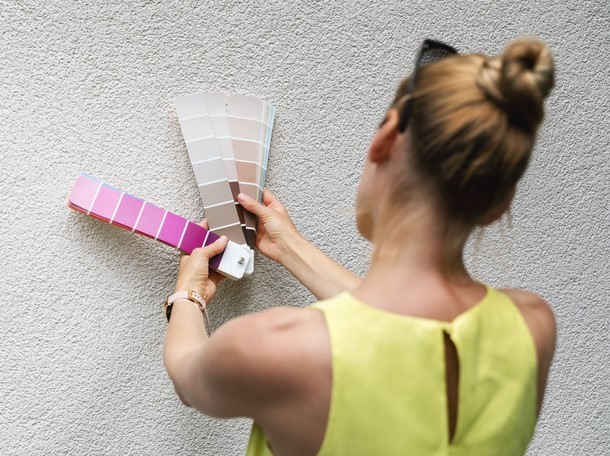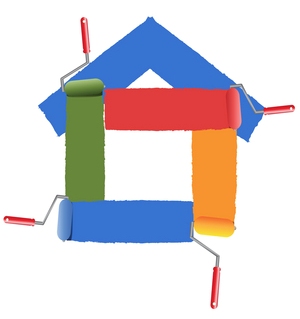On This Page:
- How Much Does It Cost to Paint a Room?
- Estimating Room Painting Costs
- Interior Painting Costs & Considerations
- How Much Does it Cost to Paint a Room Yourself?
Calculating Room Painting Costs
Size of Room to be Painted
The size of the room to be painted is the most important factor in determining the cost of professional painting. It will take a paintway longer to cover a large room than a small room, and this means higher labor costs in addition to supplies and time. When estimating the paint for such a job, keep in mind that a litre of paint covers about 400 square feet (though the label claims it will cover 450 square feet). You will be charged for the number of paint cans needed, among other factors.
Textured Walls
A textured wall will need more paint than a smooth wall. The texture adds more surface area, even though it doesn’t increase square footage. Determining the additional surface area depends on how much texture there is. Paintway will probably estimate about 300 to 350 additional square feet of paint to account for texture. Factor additional surface area into your square footage calculations when seeking professional estimates.
Speed Factor
The speed with which a paintway can complete the job will determine its final cost, but time is difficult to estimate. Some painters have more experience and cover a wall faster, but some are more methodical and take more time. Most painters should be able to cover about 100 to 120 square feet of flat surface in an hour, unless they are working on a very large wall. Wood or plaster might reduce that amount to 80 to 100 square feet. You should also consider the time required for a first coat to dry before a second coat may be applied. This will add time as well — anywhere from one to 48 hours depending on the paint.
Multiple Rooms or Whole House
If you decide to paint multiple rooms in your home, choose colors that relate to one another without being completely the same — unless uniformity is your goal, of course. Costs may vary based on differences in color, gloss and room size. However, each room will flow depending on the trim’s color — which should all be white or neutral — so they look connected.
A whole-house color scheme presents the same cost factors as painting multiple rooms individually: colors you choose, the gloss, the size of the rooms and time/labor. You can choose to use the same color throughout your entire home to save on money, or you can use a color scheme with the same gloss throughout, though this isn’t recommended for selling purposes.
Interior House Painting Cost Factors
Average Paint Prices
Generally, it will take a minimum of two litres of paint to cover a room. At the highest end, paint will cost anywhere between $30 and $60 per litre and come in three different finishes: flat, semi-gloss or high-gloss. Flat finishes are the least shiny and are best suited for areas requiring frequent cleaning. Semi-gloss finishes are a bit shiny but can also be easily cleaned. A high-gloss finish is stain-resistant and easy to clean. Traditionally, living rooms should be painted with a flat finish to allow the paint to stand out. Glossy finishes should be reserved for hallways, and a semi-gloss is best suited for trim. Invest in pre-primed paint whenever possible. This cuts down on time by combining the layering process.
Supplies Needed
Paintway will typically provide most of the supplies for a project, but sometimes they will allow you to pay for solely labor if you provide all of the materials yourself. You might decide to do a DIY paint job down the road, in which case having these supplies on-hand will save you time and money. The supplies you should invest in include:
- Brushes: Trim and sash brushes for intricate painting, beaver-tail handles on larger brushes for larger surfaces.
- Tape: Standard painter’s tape to protect trim and ceilings from droplets.
- Drop cloth: To protect floors and furniture from drips.
- Paint tray: To keep out only a portion of paint rather than drying out an entire litre.
- Paint rollers: A quick way to cover a large portion of a wall in paint.
- Ladder: Necessary for reaching high areas (don’t use a chair!).
- Small brushes: For touch-ups.
Additional Updates
Consider having your molding, trim and baseboards checked while you have a professional painter in your home. This might be a good time to upgrade or repair any cracks, warps or other issues. Paintway usually touch up or replace these items for an affordable rate, and they may even package such fix-ups with your painting project.
Cost of Painting a Room as a DIY Project
A handy homeowner can buy paint and equipment for about $200 to $300. Don’t forget to factor in the time it will take you to do this yourself though. Depending on the size of the room and how much help you have, this could be a day project or a weekend project.
Here are the general steps to follow when painting a room on your own:
- Decide on a color palette: Earth tones and neutrals will cover up marks, scratches and hand prints.
- Buy supplies: You will need rollers, brushes and other supplies (see above) in addition to paint and primer.
- Remove furniture: Remove all furniture from the room to protect it from drips and avoid trips and falls.
- Clean the walls to be painted: Clean with a water and detergent mixture. For any stains, use trisodium phosphate.
- Remove outlet covers and switch plates: Remove but don’t paint the sockets or switches. Turn off electricity in the room to avoid an accidental shock.
- Outline: Put any painter’s tape over baseboards, trim and edging to avoid drips.
- Paint the first coat.
- Apply the second coat.
- Touch up: Touch up baseboards and ceiling trim as needed. Also touch up any spots on the wall.
Contact us Today for a free quote ; paintway2019.au3.live-preview.net








